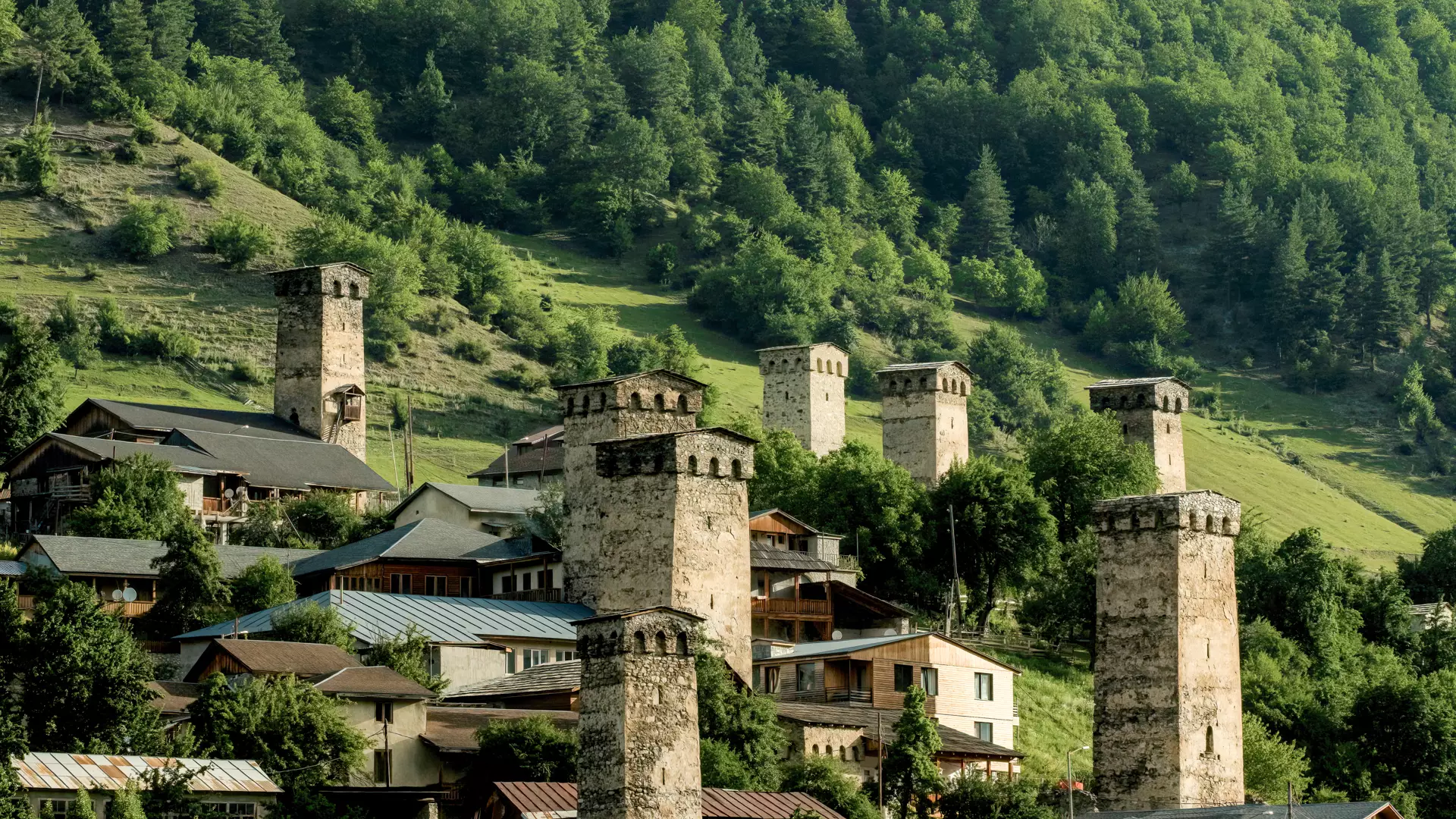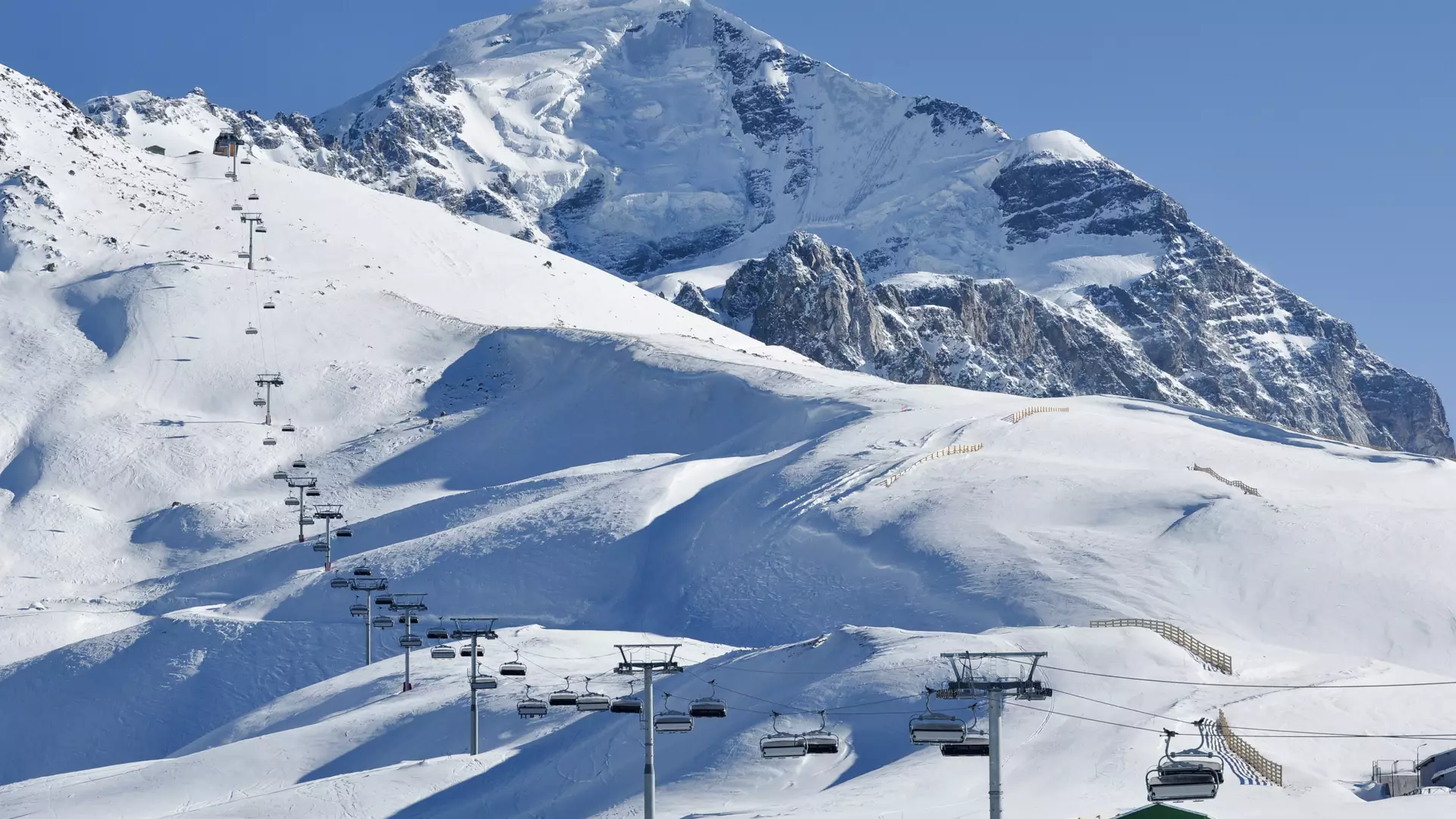9 Amazing Sights in Svaneti
Mestia
Officially, Mestia is the administrative center of the municipality, 1,500 meters above sea level in Zemo Svaneti. But unofficially, it is an amazing world on the shores of tributaries of the Enguri river, spread across the mountains.
The Svan towers are 20-to-25-meter-tall titans. Their meter-and-a-half thick walls have withstood every avalanche and enemy. The four or five stories of the towers are connected by wooden ladders and are where Svans lived with their families, with the platform placed like a crown atop the towers serving as a military headquarters.
Many defensive, religious, and secular buildings were constructed in the Middle Ages in Mestia connected by narrow streets and walled yards.
Learn more about Mestia at the Svaneti Museum of History and Ethnography. Due to its inaccessible location, Mestia kept the Georgian treasury for centuries, and you can still see a large part of it today. You will learn more about the great Svan mountain climber, Mikheil Khergiani, at the house-museum of “The Tiger of the Cliffs” which is what the British Queen, Elizabeth II, once called him during a competition.
The Svan character is mentioned in local dances and songs, so make sure to visit the Mestia Culture and Art Center to learn more. For the full experience, try unique Svan dishes anywhere, in hotels, restaurants, or with a hearty Svan family that would love to host you.
Now let’s get back to the nature grandeur. Two stars of the Svaneti show are the Tetnuldi and Hatsvali mountain-ski resorts.
Tetnuldi Ski Resort
The 2022 Freeride World Tour qualifying round was held at the Tetnuldi ski resort. It was so impressive, that the commission decided to have the competition here every year. It is hardly surprising, given that Tetnuldi is one of the best places in Georgia for backcountry skiing.
One of Svaneti’s most beautiful mountains, Tetnuldi, is in the alpine zone. Five high-capacity, rapid cable cars go up to the resort’s 13 kilometers of ski slopes, which are intended for intermediate and well-experienced skiers. The cable cars will take you up to 3160 meters, and you can ski down to 2260 or 1300 meters.
Freeriding on Tetnuldi is great because you have nearly unlimited opportunities to descend. You can ski off-piste between the slopes, but it is spectacular to ski down the mountain through the villages. Just imagine skiing on perfect powder and then stopping right in front of your hotel. In a single day, you can ski down a few times through the Mulakhi and village Adishi communities.
You can go even higher before skiing down by planning a ski tour. Tetnuldi is 4852 meters high, and you can reach its peak from the upper stop of the cable car if you schedule a tour. You get exceptional views of the Caucasus Mountains if you ski down the Tetnuldi slopes.
The cable cars near Mestia bring you up to Tetnuldi. In Tetnuldi, there are no hotels, only a few dining areas, so spend the night in Mestia or a nearby village. Purchase a multi-day pass at the cable car counter, since you can use it for the cable cars at other ski/mountain resorts, like Hatsvali, which promises to be just as enjoyable.
Hatsvali Resort
Hatsvali is a great choice for an active vacation both in winter and summer. Next to the upper station of the cable car, 2345 meters above sea level, is the bustling Zuruldi Café with exceptional views that you will never forget.
In summer, you can go for a walk, have a picnic, ride a bike down the mountain, or go paragliding in Hatsvali. The enclosed cable cars will take your bike and any equipment up to the mountain peak. You can ride down from the top of the mountain to Mestia and its nearby villages or paraglide into Mestia, both with beautiful views of Svaneti, with the Elbrus, Ushba, and Svan towers in the background.
Relaxing at Zuruldi, skiing down the peak to the villages, and the amazing views all around, are great activities to enjoy during the winter. There are 5495 meters of ski slopes, and you are in luck if you love off-piste skiing, because the Hatsvali Forest Freeride passes through the forest. The snow in the dense fir groves retains its quality for a long time, so skiing is truly unforgettable.
Two cable cars will take you up to Hatsvali, each with gondolas and seats. Two restaurants operate, one near the cable car and one on top of the station. There are no hotels at Hatsvali, so you will have to stay the night at a hotel in Mestia or a guesthouse in one of the nearby villages.
Ushba
According to Svan legend, Tetnuldi is a petrified bride who eternally looks at her love, who is also petrified - the twin peak of Ushba. The legend tells us that Tetnuldi and Ushba were of different social classes, and, even though they were in love, their families were against their relationship. One day, in frustration, Tetnuldi put on a white wedding dress and prayed to God, “If Ushba and I are not fated to be together, then turn us into mountains, so that we can always be looking at each other.” That is how the beautiful peaks of Tetnuldi and Ushba came to be in the Caucasus Mountains of Svaneti.
Ushba has two peaks, its southern peak is 4,700 meters high, and its northern peak is 4,690 meters high. The peak, made of Paleozoic granite and shale, is 10 kilometers from Mestia. There are two gorgeous glaciers on its slopes, Ushba Glacier and Guli Glacier. Due to its beauty and inaccessibility, Ushba is a prime location for mountain climbers.
From a technical point of view, its northern peak is easier to climb than its southern one, but that did not help the English alpinists who tried to climb Ushba in 1868. It was twenty years later, in 1888, that a second English group managed to do it, on their fourth attempt. As for the southern peak, it was only conquered on the sixteenth attempt by a German/Swiss group.
The first Georgian group climbed Ushba in 1943. One person was Aleksandra Japaridze, the first female mountain climber to reach the peak of Ushba. Four years later, a Georgian group of mountain climbers climbed the difficult southern peak of Ushba. Nowadays, 19 routes make up that part of Ushba, seven of which are extremely difficult and categorized at 6A. There are four, 6A routes out of 13 total on the southern peak of Ushba.
If you love mountain climbing, visit Ushba up close and personal.
Shkhara
Shkhara, made of granite and shale cliffs, is the tallest peak in Georgia, at 5203 meters above sea level. Shkhara means “nine” in Svan, which is exactly the number of peaks the mountain has, and there is no easy way to climb it, nor simple or intermediate routes. All routes have a range of difficulty ratings, from 5A-6A.
The first peak of Shkhara was summited by a Swiss/British group of mountain climbers from the North Caucasian side in 1888. Georgian mountain climbers achieved an unprecedented traversal of Shkhara in 1940, and Georgians also accomplished the first crossover from the southern slope of Shkhara to the main peak in 1950, now considered the classic route.
In the 1960s, Georgian mountain climbers discovered several new routes on the western and central peak of Shkhara, but the decade also turned out to be tragic, because, in 1963, the 31-year-old Georgian mountain climber and photographer, Guram Tikanadze, tragically died while descending the main peak of Shkhara.
The most difficult route is the grandiose 6B winter traversal from Lialveri to Shkhara, which was accomplished in 2014 by a group of mountain climbers from Saint Petersburg. The first winter ascent to the highest peak of Shkhara in 2018 is also a 6B route. This major challenge of the Caucasus Mountains was summited by Georgian mountain climbers. The route, from the ascent to the descent, took 13 days.
Shkhara is beautiful, but severe, although you too can climb it with a professional guide if you really want it.
Ushguli
One of Europe’s highest settlements, Ushguli, is on the slopes of Shkhara, 2200 meters above sea level.
The paths from the Ushguli community, which consists of five small villages, will take you to the highest peaks of the Caucasus Mountains.
Because the roads leading to Ushguli, area were only passable for a few months out of the year, enemies were never able to reach it.
It is said that the name Ushguli comes from “ushishari guli” (“fearless heart”), just as this community without a master and its inhabitants were called.
In addition to the fantastic views, in the villages of the Ushguli community, you will find an impressive amount of well-preserved Svan towers. The architecture of this place - religious, residential and agricultural buildings, the famous Lamaria Church, the ruins of the fortress built during the reign of Queen Tamar - is truly unique. That's why Ushguli is on the UNESCO World Heritage List.
As you enjoy the beautiful view, your thoughts will turn to food, which is a separate adventure in itself. The exotic flavors of Svan cuisine are just one more argument as to why you should put Ushguli, the most extreme point of Svaneti, on your list of places to go.
Kinuli Lake
Kinuli Lake is 3200 meters above sea level near Nakra village in Mestia Municipality. To get there, follow Tsalgmila peak near Chube Valley to the east. The lake is completely frozen sitting among the ice-covered mountains.
Kinuli Lake, 150 meters long and 50 meters wide, has a surface area of 5300 square meters. Above it, the highest peak of the Caucasus Mountains, the Elbrus, and also Ushba, stand tall. Take in these beautiful sights any time of the year, but it is best to go in the summer when you can enjoy the color changes.
The Lakes of Okrotskali
The large and small lakes of Okrotskali are in the Chuberi community. The large lake is 2400 meters above sea level, and the small lake is 2700 meters above sea level. The paths to the lakes start in Lakhami village and pass through Ormeleti Valley. The 25-kilometer paved road turns into a footpath and after seven to eight kilometers of grass and forest, you arrive at the lake.
The large Okrotskali Lake appears first, changing colors a few times throughout the day, sometimes green, sometimes dark blue, sometimes turquoise. The small Okrotskali Lake is about 2.5 kilometers away, very close to occupied Apkhazeti. Along the way, you will come across a beautiful waterfall.
The Tower of Love
One of the most emotional legends in Svaneti is the Tower of Love, on the way from Mestia to Ushguli, on the shore of the Enguri river, atop a large boulder. The 3-story tower is connected by steep stairs.
According to the legend, this is the tower of Miaguli, a Svan noblewoman. During the Kvirkoba folk festival, she met and fell in love with the famous hunter, Otia Margvelani. He also fell in love with her but he had a wife and children, and Miaguli did not wish to be a homewrecker.
Otia, heartbroken, left for a hunt and fell off a cliff into the Enguri river. His wife could not bear her husband’s death and leaped into the Enguri where they turned into trout. Miaguli, in distress, asked her father to build her a tower in the Enguri River for her to live and feed the trout with her hands until the end of her life.
Svans will tell you that, when the Enguri river lowers, the clear water that comes up from the under the cliffs are Miaguli’s tears.
Cookie Policy








